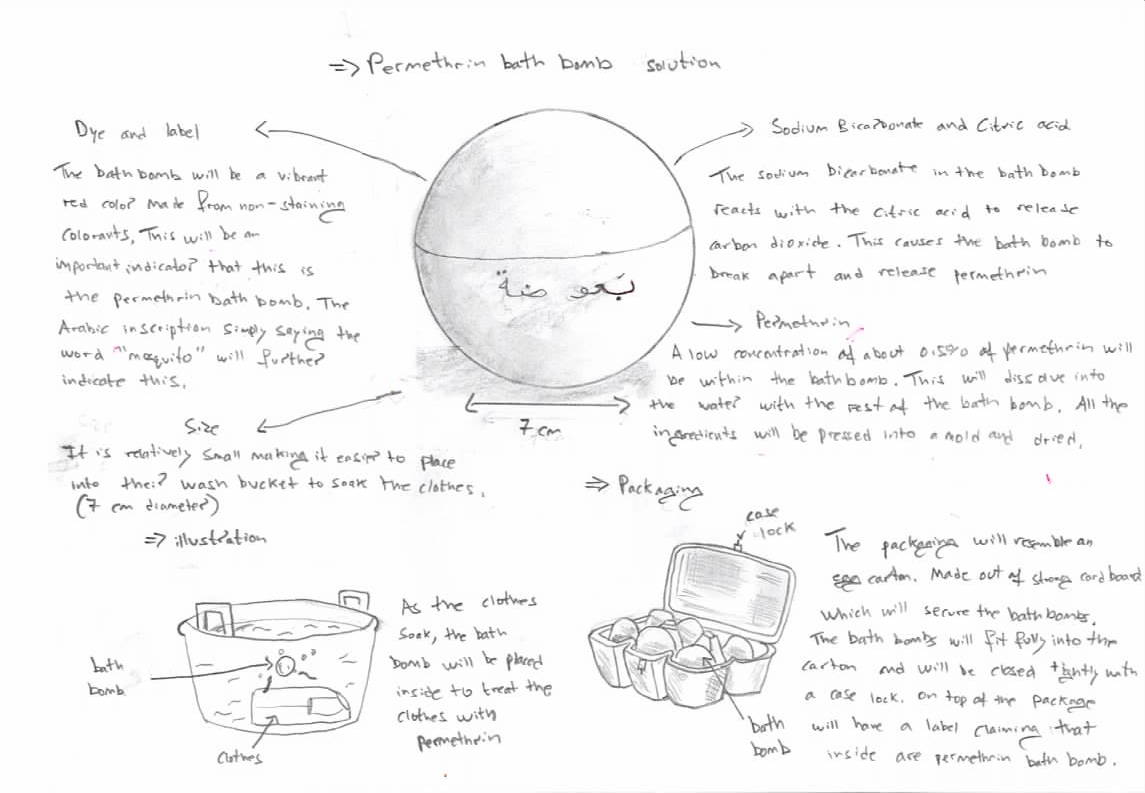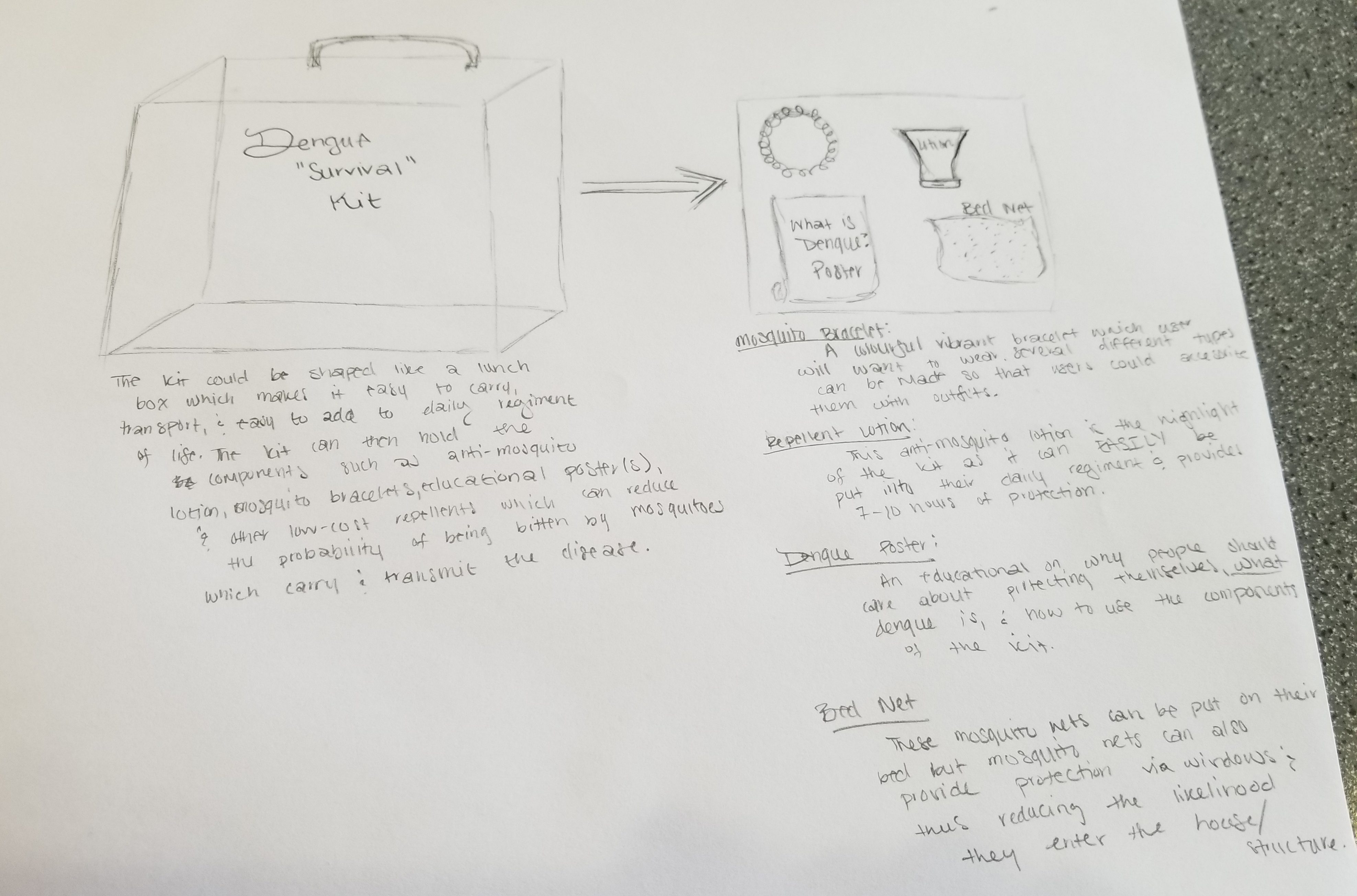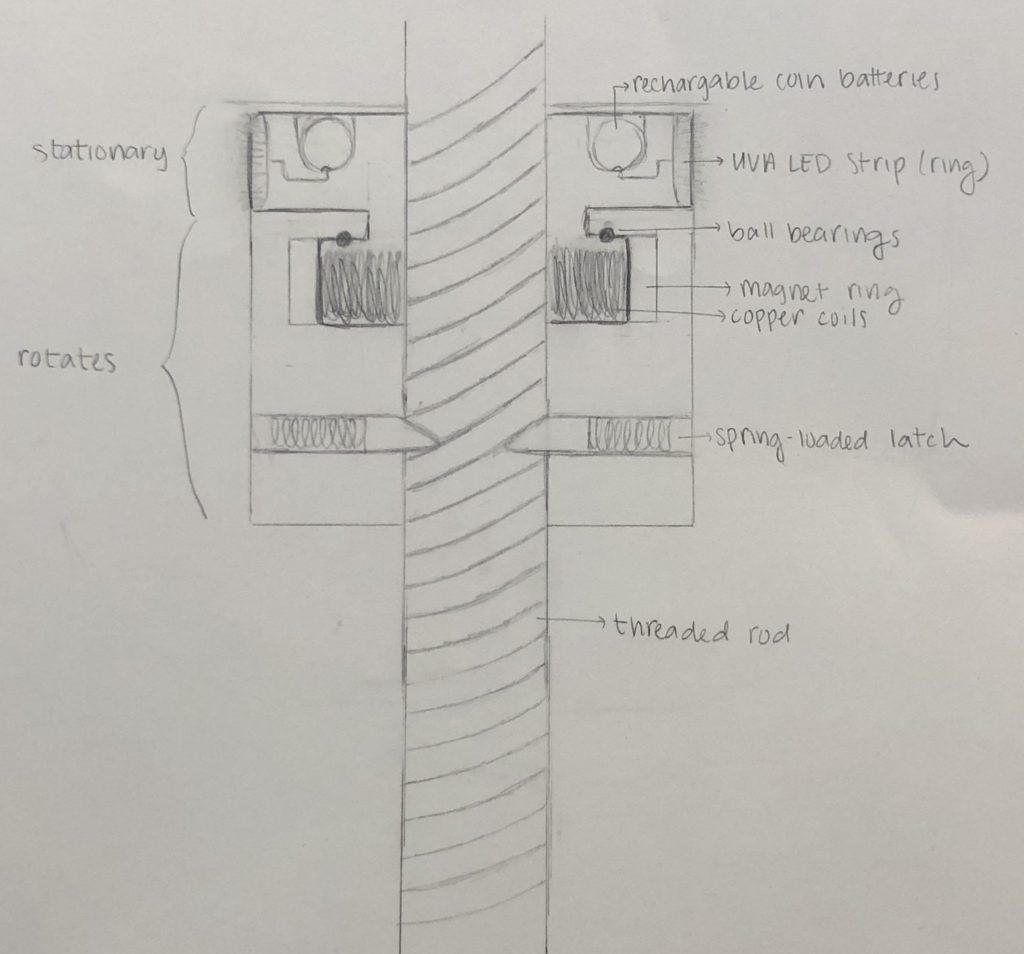Permethrin bath-bomb solution
This solution is a bath bomb containing the chemical permethrin.
Firstly, a bath bomb is a hard-packed mixture of ingredients which effervescence when it comes into contact with water and permethrin is a synthetic version of a chemical produced naturally by the chrysanthemum flower and is an insecticide. It is often put on clothes as a spray and it bonds to fabric killing ticks, mosquitoes, and insects that land on them.
This solution combines these two things to create a permethrin bath bomb. People would place this bath bomb into water, soak they clothes into the water and air the clothing. Once dry, the clothes will contain permethrin. The bath bombs would be distributed to people in small packets. With the bath bombs there will be reusable gloves and instructions on how to use the bath bombs. Furthermore, the education aspect will also include how to use the bath bombs and in community gathering areas, such as at local mosques, they can also discuss how to use these bath bombs. The information would include how many bath bombs to use, safety, how long to soak clothes for, etc.
Permethrin is the most effective chemical for this solution. Firstly, permethrin-treated clothes are still effective even after multiple washes. For example, a study illustrated that for the genus Aedes mosquitoes, that cause dengue, “the toxic effect of permethrin reduced biting rates by greater than 90% within the immediate area where subjects wore permethrin-treated uniforms for 9 hours.” (“The effectiveness of permethrin and deet, alone or in combination, for protection against Aedes taeniorhynchus,” 1984). This is ideal in Yemen as they are currently struggling with a water storage crisis and so cannot wash or treat their clothes with this chemical regularly so the long-lasting effect will benefit them greatly.
Furthermore, it is an inexpensive chemical. A large gallon cost between from 30 to 100 dollars. For example, a Martin’s Permethrin SFR Insecticide contains 36.8% of permethrin in 1.25 gallons. Thus, is not expensive to create small bath bombs. Moreover, the bath bombs will be diluted so it will not dangerous but still be effective, at most a 0.5% concentration.
Moreover, in terms of toxicity, Connecticut Department of Public Health, claimed that it “has low mammalian toxicity, is poorly absorbed through the skin, and is rapidly inactivated by the body… Skin reactions have been uncommon.” (Stafford C. K. III, 1999). Thus, the clothes would protect them without causing harm.
However, there are some limitations to this solution.
After using permethrin, the water must be discarded. This may pose a problem in Yemen, as the water is very scarce, and they may want to recycle it which would not be possible after using permethrin and so may decide simply not to use it. Furthermore, considering that Yemen is a very hot country the men and children may wear loose clothing or short sleeves making the solution ineffective as they will still be exposed to the mosquitoes. Moreover, although it is not toxic, the Environmental Protection Agency classifies it as a likely human carcinogen if consumed which may also pose some health risks. (“How Permethrin-treated Clothing Keeps You Safe”, 2018). Moreover, this will not only kill mosquitoes but also ticks and other insects which may cause harm to the ecosystem as untargeted organisms are being killed.
However, despite these limitations the solution is very simple, cheap and effective. Therefore, will be very beneficial in our particular context in Yemen.

Dengue Survival Kits
The Description of Dengue Survival Kits: Dengue surviving kits are a package of basic tools and supplies prepared in advanced as aids to the people suffering from emergency Dengue disease resulting from Aedes mosquito bites. These Dengue surviving kits include mosquito bed-nets, mosquito repellent lotions, mosquito repellent bracelets and others
The Cost of These Products: These products are inexpensive. For instance, Mosquito repellent lotions prices range from $4.00 to $29.00, 10 packs of mosquito repellent bracelets cost $9.99 and mosquito bed-nets cost $29.99. However, since we are working with WHO and other sponsoring organizations, we would be able to get financial support from these donor organizations to enable us to acquire these products for the people in Yemen for free of charge.
How to Use These Kits:
- Mosquito Repellent Lotions: Pour the lotion into your palms and smear it gently on your face, around your chin and your eyebrow. Spread it around your neck, shoulders, torso (back and front), elbows, arms, fingers, thighs, knees, legs and the feet. Wait for at least 30 minutes for the lotion to dry on your face and all parts of your body before going to bed to avoid wiping out of the lotion from your body by the bed sheet. Close the lid of the lotion tightly after use to avoid leak out of the lotion. Keep the lotion out of reach of children before and after use.
- Mosquito Repellent Bracelets: These bracelets contain non-toxic natural ingredients Citronella, Lemongrass and Geraniol that are proven to repel mosquitoes from coming into contact with humans. These bracelets are worn like wearing a wrist watch or a wrist band. Each bracelet worn on your wrist can last for 7 days before replacing it with a new one.
- Mosquito Bed Net: Open the mosquito bed net on your bed and tuck it under your mattress to keep the mosquitoes out. Tuck the mosquito net over a crib under the mattress. Pull the mosquito net to cover the entire bed from the top to the floor to block any possible way of entry by the mosquitoes. If the mosquito bed net is sagging in towards the sleeping area, pull it tightly to the other objects and tie it to that to avoid choking a child on the bed.
How These Products Are Effective:
- Mosquito Repellent Lotion: These lotions are effective in repelling Aedes mosquitoes from biting. However, a literature review by Lupi, Hatz and Schlagenhauf shows that it only lasts for 480 hours.
- Mosquito Bracelets: These products are effective in repelling mosquitoes from coming into contact with humans. However, it only lasts for seven days. It needs a replacement every seven days.
- Mosquito Bed Nets: These bed nets are effective in repelling mosquitoes because they offer the sleeper barriers protection against bites from mosquitoes. Research has shown that mosquito bed nets are an effective method of mosquito prevention. Mosquito bed nets helped to prevent approximately 663 million cases of mosquito-caused diseases over the period of 2000 to 2015.
The Limitations of The Use of These Dengue Survival Kits:
- Mosquito Repellent Lotions: Easy to contaminate and stain the bed sheet, the pillows and other clothing materials on the bed. Bed sheets and pillows need to be washed frequently to avoid odor if the user sweats a lot during sleeping.
- Mosquito Repellent Bracelets: Safe to use but lasts for only seven days. It must be replaced every seven days.
- Mosquito Bed Nets: It needs frequent monitoring to ensure that it does not choke any child sleeping on the bed. It becomes unsafe to use it to protect against mosquito bites if part of it is torn.

Self-propelled Mosquito Trap
One of our tentative solutions to the dengue crisis in Yemen is an extension of an existing contraption developed by the CDC, known as a CDC trap. The CDC trap is a mosquito trap initially designed to catch mosquitoes so that CDC researchers may study mosquito populations in a specific area and identify the illnesses they transmit. The CDC trap employs a small fan (powered by a 6V battery) mounted at the top of a net trap. A light and CO2 bait source are located just below the fan in order to attract mosquitoes, and the fan propels them down into the net trap where they eventually die of exhaustion (The VDCI Team, 2017).
Much like the CDC trap, our trap would utilize a light source as an attractant. A study published in Florida Entomologist suggests that blacklight is the most effective at luring mosquitoes in while simultaneously capturing the fewest “non-target insects” (University of Florida Institute of Food and Agricultural Sciences, 2015) . The two mosquito species responsible for transmitting dengue in Yemen, Aedes albopictus and Aedes aegypti, tend to be daytime biters, making visual attractants more effective. Thus, our trap would employ a blacklight to attract the mosquitoes.
The remaining parts of this solution are intended to trap and kill as many mosquitoes as possible. Using a small fan at the top would propel any nearby mosquitoes down into the trap. Portable, battery-powered fans can be found on Amazon.com for around $8-12 USD (“Amazon.com: O2COOL 5″ Portable Fan Battery Powered 1 Unit Grey: Home & Kitchen,” n.d.), (“Amazon.com: Cooler Master SickleFlow 120 – Sleeve Bearing 120mm Blue LED Silent Fan for Computer Cases, CPU Coolers, and Radiators: Electronics,” n.d.). A net with tight-nit mesh would be utilized below the fan to catch any mosquitoes. The entire trap would be coated in an insecticide to kill any mosquitoes that touch it but are not trapped by the fan and net. We have chosen to use Actellic 300CS because of its ability to kill pyrethroid-resistant mosquitoes and its ability to remain effective for up to 9 months outdoors (Hoppé, Hueter, Bywater, Wege, & Maienfisch, 2016).


The goal was to engineer a contraption that could be either self-propelled – or at least require minimal interaction. Our solution, as can be seen in the above sketches, revolves around a tightly-threaded pole that mounts directly into the ground. The mechanism attaching to the pole is separated into two parts, which glide across each other using a ring of ball bearings. The lower half of the mechanism involves two spring-loaded latches on opposite sides of the pole, which hold the mechanism inside the threads while descending (ascension will be discussed shortly). Fan propellers would be mounted around the mechanism here. The upper half of the mechanism does not rotate. It houses a ring of copper coils and an outer ring of magnets that create an electromagnetic field, propelling the rotation. Above the coils is a UVA LED strip ringing the upper outside of the trap, to lure in mosquitoes. This light would be powered by several coin batteries, which insert into the mechanism and “click” into place under a protective silicone covering. Mounted above this mechanism would be several stabilizing bars that hold the top of the mosquito net. The net hangs down like a basket and creates a seal around the pole.
The key feature of this design is the spring-loaded latches which insert into the threads of the supporting pole. The weight of the contraption would slowly pull the fan along the threads down the poll, forcing the fan blades to rotate. When the fan reaches the bottom – presumably several times a day – strong cords that exit near the bottom of the poll would be pulled to hoist the fan back to the top. The latches are designed to retreat into the mechanism at this point, bypassing the threads for ascension. When the pulling chords are released, the latches hook into the nearest thread, and the fan again begins its fall.
A tentative cost analysis has been done on some of the required materials. Actellic 300CS costs roughly $23 USD per bottle, although funding through organizations like NGenIRS have dropped the price to around $15 USD (President’s Malaria Initiative, 2017). One bottle of this insecticide could be used to treat hundreds of these mosquito traps, although that figure requires further analysis. We must perform additional research to identify the costs of the remaining required materials.
With further tweaks, this design is a feasible one. Partnered with our educational component, the people of Yemen would quickly appreciate the dangers that dengue-transmitting mosquitoes present. This trap would not take up valuable space inside of the home and requires little maintenance. The trap is modular by nature and would be easy to assemble when provided with text-free pictorial instructions. Many of the components that make up this trap could be constructed from affordable materials; the most expensive components will be the magnets and copper wire.
Decision Matrix: Choosing a Solution
| Mosquito Trap | Dengue Survival Kit | Bath Bomb | |
|---|---|---|---|
| (4) Cost | 1 | 4 | 4 |
| (6) Longevity/Durability | 5 | 3 | 4 |
| (9) Human Safety | 5 | 5 | 3 |
| (10) Applicable to Yemen/Context | 5 | 5 | 5 |
| (3) Environmental Safety | 5 | 5 | 3 |
| (2) Ease of Distribution | 3 | 3 | 4 |
| (5) Range of Impact | 5 | 3 | 3 |
| (1) Learnability | 1 | 2 | 2 |
| (7) Required Skills | 3 | 3 | 2 |
| (8) Acceptability Factor | 5 | 5 | 5 |
| Totals | 237 | 228 | 205 |
As a team, we decided on the ten most important factors that would determine whether a specific solution should be used. Once we had our list, we ranked them on a scale from 1-10, with 10 being “most important.” For each solution, we then ranked how well that “importance/relevance factor” applied on a 1-5 scale. The 10 factors and a brief description of each are listed below, in order of increasing importance.
- Learnability: How easy is it for our target population to learn how to implement this solution?
- Ease of distribution: Is it portable? Easily distributed?
- Environmental Safety: How harmful is it to the environment?
- Cost: How much does one unit cost?
- Range of Impact: How many people does a single unit protect? Is it per person? Per household?
- Longevity/Durability: How long does the solution last? Does it require maintenance?
- Required Skills: What are the skills required of our target population to be able to use this solution? Does it require any physical skills? Are they required to read accompanying safety documentation? Assembly instructions?
- Acceptability Factor/Willing to Implement: How willing is our target population to integrate this solution into their daily lives? Does it integrate well with their lifestyle?
- Human Safety: How safe is it for human use? Are there any risk factors?
- Applicable to Yemen/Context: Does this solution apply to our target population of Yemen? Can it be used in their current situation/environment?
An analysis of the decision matrix shows that the mosquito trap solution had the highest point value; therefore, this is the solution we will implement. Items to focus on moving forward include: a more in-depth cost analysis of materials, a feasibility study, and further development of our educational component.
Click here for the current draft of our educational poster.
References
7 Mosquito Repellent Plants – Garden Design. (n.d.). Retrieved April 24, 2019, from GardenDesign.com website: https://www.gardendesign.com/plants/mosquito-repellent.html
7 ways to prevent mosquito bites. (n.d.). Retrieved April 24, 2019, from https://www.onemedical.com/blog/live-well/7-ways-to-prevent-mosquito-bites
Almanac, O. F. (n.d.). Mosquito Repellents and Bite Remedies. Retrieved April 24, 2019, from Old Farmer’s Almanac website: https://www.almanac.com/content/how-deter-mosquitoes-and-treat-bug-bites
Amazon.com: Cooler Master SickleFlow 120 – Sleeve Bearing 120mm Blue LED Silent Fan for Computer Cases, CPU Coolers, and Radiators: Electronics. (n.d.). Retrieved April 23, 2019, from https://www.amazon.com/Cooler-Master-SickleFlow-120-Radiators/dp/B0026ZPFCK
Amazon.com: O2COOL 5″ Portable Fan Battery Powered 1 Unit Grey: Home & Kitchen. (n.d.). Retrieved April 23, 2019, from https://www.amazon.com/O2COOL-Portable-Battery-Powered-Unit/dp/B001B16VT6?ref_=fsclp_pl_dp_1
CDC. (2018, May 1). Mosquito Bites: Everyone is at Risk! Retrieved April 24, 2019, from Centers for Disease Control and Prevention website: https://www.cdc.gov/media/dpk/diseases-and-conditions/mosquito-borne-diseases/index.html
Hoppé, M., Hueter, O. F., Bywater, A., Wege, P., & Maienfisch, P. (2016). Evaluation of Commercial Agrochemicals as New Tools for Malaria Vector Control. CHIMIA International Journal for Chemistry, 70(10), 721–729. https://doi.org/10.2533/chimia.2016.721
Lupi, E., Hatz, C., & Schlagenhauf, P. (2013). The efficacy of repellents against Aedes, Anopheles, Culex and Ixodes spp. – a literature review. Travel Medicine and Infectious Disease, 11(6), 374–411. https://doi.org/10.1016/j.tmaid.2013.10.005
Maia, M. F., Kliner, M., Richardson, M., Lengeler, C., & Moore, S. J. (2018). Mosquito repellents for malaria prevention. The Cochrane Database of Systematic Reviews, (2). https://doi.org/10.1002/14651858.CD011595.pub2
Permethrin-Treated Clothing for Insect Protection. (2018, August 15). Retrieved April 24, 2019, from Modern Pest website: https://www.modernpest.com/blog/how-permethrin-treated-clothing-keeps-you-safe/
Schreck, C. E., Haile, D. G., & Kline, D. L. (1984). The effectiveness of permethrin and deet, alone or in combination, for protection against Aedes taeniorhynchus. The American Journal of Tropical Medicine and Hygiene, 33(4), 725–730.
The VDCI Team. (2017). Mosquito Surveillance Traps: Are They All The Same? Retrieved April 17, 2019, from http://www.vdci.net/blog/mosquito-surveillance-traps-are-they-all-the-same
Tick Bite Prevention. (2005, September 12). Retrieved April 24, 2019, from https://web.archive.org/web/20050912070432/http:/www.dph.state.ct.us/BCH/infectiousdise/tickborne/tick.htm#Permethrin
Webb, C. (n.d.). Health Check: do wrist bands work to repel mozzies? Retrieved April 24, 2019, from The Conversation website: http://theconversation.com/health-check-do-wrist-bands-work-to-repel-mozzies-50186
